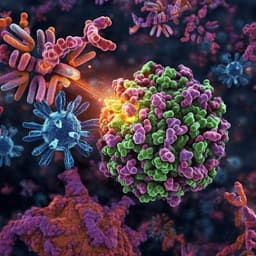
Medicine and Health
Previous immunity shapes immune responses to SARS-CoV-2 booster vaccination and Omicron breakthrough infection risk
L. Pérez-alós, C. B. Hansen, et al.
This groundbreaking study reveals the pivotal role of prior SARS-CoV-2 infection and vaccination in shaping immune responses to a third BNT162b2 vaccine dose. Conducted by a team of experts, it highlights how robust IgA responses are crucial for preventing Omicron breakthrough infections, with fascinating insights into the dynamics of humoral and cellular responses. Explore how prior infections influence future immunity!
~3 min • Beginner • English
Introduction
SARS-CoV-2 vaccines markedly reduce severe COVID-19 but are less effective at preventing transmission, especially with immune-evasive variants such as Omicron. As population immunity has diversified through vaccination and repeated infections, interindividual variability in immune responses and susceptibility to breakthrough infections has increased. Key factors include age, sex, comorbidities, medications, and prior SARS-CoV-2 infection. Hybrid immunity is expected to enhance protection, potentially through stronger and more sustained IgA responses, yet its relationship to breakthrough infection risk remains unclear. Immune imprinting (original antigenic sin) may constrain responses to new variants after priming with ancestral antigens and could affect both B- and T-cell responses. The study investigates how previous infection and vaccination shape booster-induced humoral (IgG, IgA, neutralizing antibodies) and cellular (T-cell IFN-γ) responses, their association with reinfection and future Omicron infection risk, and the potential role of immune imprinting.
Literature Review
Prior work shows substantial interindividual variation in vaccine-induced immunity, influenced by demographics and prior infection. Vaccination alone induces limited mucosal IgA, whereas hybrid immunity often elicits stronger, more durable IgA. Immune imprinting, first described for influenza and later in HIV and dengue, has been implicated in SARS-CoV-2 and may dampen responses to divergent variants after priming with ancestral antigens. Studies report reduced neutralization of Omicron by vaccine-induced antibodies and relatively preserved T-cell responses that protect against severe disease. Correlates of protection suggest neutralizing and binding IgG antibodies associate with reduced infection risk, but the protective role of circulating IgA is variable and may be modest and short-lived compared to IgG. Evidence also suggests Omicron breakthrough infections can limit antibody boosting in those previously infected with distant strains, consistent with imprinting effects.
Methodology
Design: Prospective longitudinal observational study among Danish healthcare professionals at Copenhagen University Hospital (Rigshospitalet, Herlev-Gentofte). Participants received three doses of BNT162b2 (Pfizer-BioNTech) with booster administered a median of 295 days after the first dose. Sampling occurred at baseline, 21 days, 2 months, 6 months, and 12 months after first dose (T-cell samples at 6 and 12 months only).
Cohort: 1,325 participants (86.4% female; median age 52 years). At 12 months, 955 were infection-naive; 370 had hybrid immunity (207 infected before Omicron dominance—Ancestral n=100, Alpha n=38, Delta n=69; 163 infected with Omicron). Reinfection subgroup included previously infected individuals with subsequent Omicron reinfection by or after 12 months.
Infection definitions: Prior infection defined by anti-N positivity and/or RT-PCR. Reinfection defined as two positive RT-PCRs ≥60 days apart (or N-seropositive in 2020 plus RT-PCR ≥60 days later). Omicron infections defined by RT-PCR after December 20, 2021 (BA.1 predominance) in Denmark.
Assays: Anti-RBD IgG and IgA quantified by validated in-house ELISA (AU/ml); positivity thresholds: IgG >225 AU/ml, IgA >100 AU/ml. Neutralizing antibodies measured via surrogate ELISA-based ACE2-RBD inhibition assay (IU/ml), threshold 420 IU/ml, correlated with PRNT (r=0.9231). T-cell responses measured as IFN-γ release after S1 peptide stimulation (EUROIMMUN IGRA), quantified by ELISA (mIU/ml), threshold 200 mIU/ml.
Statistical analysis: Nonlinear dynamics modeled using generalized linear mixed models (GLMMs) with natural cubic splines over 0–443 days. IgG and nAbs modeled with Gaussian GLMMs; IgA modeled as binary outcome (positive vs non-positive) via binomial GLMM; IFN-γ modeled with linear mixed models (two timepoints). Two-part independent models were used to project waning up to boost and post-boost peaks when direct observations were sparse (days 250–350). Covariates: infection status (infection-naive, infected before Omicron, infected with Omicron), reinfection status, future infection status, immune imprinting comparison, age group (<40, 40–60, >60), sex, and time from vaccination/infection. Correlations between IFN-γ and IgG/IgA assessed by Spearman’s rank. P<0.05 considered significant.
Subgroup analyses: (1) Reinfection cohort: previously infected before Omicron, comparing those reinfected vs not; (2) Future infection cohort: infection-naive at 12 months, comparing those who later became Omicron-infected vs those who did not; (3) Immune imprinting cohort: previously infected before Omicron and reinfected with Omicron vs infection-naive with primary Omicron infection.
Key Findings
- Cohort and infection status:
- 1,325 participants; 86.4% female; median age 52 (IQR 41–59).
- 955 infection-naive at 12 months; 463/955 (48.5%) became infected with Omicron after 12-month sampling (future infected).
- 370 with hybrid immunity: 207 infected before Omicron (Ancestral 100, Alpha 38, Delta 69); 163 infected with Omicron. Among those infected before Omicron, 78/207 (37.7%) were reinfected by or after 12 months.
- IgG dynamics and sex/age effects:
- IgG peaked after prime then waned; booster restored IgG to prime-like levels across groups.
- Individuals infected before Omicron had consistently higher post-boost IgG than infection-naive (e.g., females <40: 23,821 AU/ml [95% CI 19,433–29,241] vs 14,999 AU/ml [95% CI 13,163–17,131]). Females >60 infected before Omicron showed highest post-boost IgG (e.g., 41,708 AU/ml [95% CI 30,683–57,099]).
- Significant interaction between time and sex in infection-naive (p=0.011): after boost, males > females, opposite to prime; not seen in hybrid immunity, where females > males.
- Peak IgG after prime was lower in Omicron-infected compared with infection-naive.
- Neutralizing antibodies (nAbs):
- Booster substantially increased nAbs beyond prime in all groups; hybrid immunity, particularly recent Omicron infection, showed highest nAbs.
- Aging associated with lower nAbs after prime but similar levels across ages after boost. Sex association (p=0.037): females higher after prime; males increased more post-boost, yielding comparable levels.
- IgA responses:
- Probability of positive IgA increased after booster across groups; dynamics differed by infection status (p<0.001).
- Infected before Omicron maintained >25% positivity over time and improved after boost. Recently infected (Omicron) had greatest post-boost IgA increase.
- Infection-naive had poorer post-boost IgA vs hybrid immunity (e.g., females <40: 33% [95% CI 22–46%] vs 82% [95% CI 73–90%]).
- Those who later became Omicron-infected had lower IgA positivity after prime vs those who remained naive (e.g., females <40: 44% [95% CI 29–59%] vs 67% [95% CI 57–77%]). No sex differences (p=0.581).
- T-cell responses (IFN-γ):
- IFN-γ increased after boost in infection-naive and Omicron-infected (p<0.001), but not in those infected before Omicron (p=0.100); Omicron-infected had highest post-boost IFN-γ.
- Age effect (p=0.006): younger had higher IFN-γ; males lower than females (p=0.033).
- Significant IgG–IFN-γ correlations at 6 and 12 months (overall R=0.47 at 12 months, p<0.001). IgA–IFN-γ correlation context-dependent; overall R=0.36 at 12 months (p<0.001).
- Reinfection risk (previously infected before Omicron):
- During waning (between prime and pre-boost), future reinfected vs not reinfected had lower IgG (p=0.007), IgA (p=0.024), and nAbs (p=0.035); IFN-γ not different (p=0.340). GLMM dynamics differed for IgG (p=0.044) and nAbs (p=0.016); trends for IgA (p=0.099) and IFN-γ (p=0.118).
- Future Omicron infection risk (infection-naive after boost):
- At ~day 15 post-boost, those who later became infected had lower IgG (p=0.009), IgA (p=0.031), and nAbs (p=0.028); IFN-γ similar (p=0.510). GLMMs showed differing dynamics for IgG (p=0.023), nAbs (p=0.028), IgA positivity (p=0.028); IFN-γ dynamics also differed (p=0.006).
- Immune imprinting (reinfection vs primary Omicron after boost):
- Primary Omicron infection (previously naive) exhibited higher IgG (p<0.001), IgA (p=0.013), and nAbs (p=0.019) than those reinfected after a pre-Omicron infection; IFN-γ similar at the comparison timepoint (p=0.270). GLMMs showed greater increases over time in IgG and nAbs (p<0.001) and IFN-γ (p=0.001) in primary Omicron; IgA dynamics borderline (p=0.064).
- Overall: Hybrid immunity enhances humoral responses, especially IgA; lower humoral (IgG, IgA, nAbs) but not T-cell responses associate with higher risk of breakthrough infection and reinfection; evidence consistent with immune imprinting dampening responses in those infected before Omicron and reinfected with Omicron.
Discussion
The study addresses how prior SARS-CoV-2 exposure and vaccination history modulate booster-induced immunity and subsequent infection risk in the Omicron era. Findings show that prior infection (hybrid immunity) augments humoral responses, particularly IgG, nAbs, and notably IgA, compared with vaccination alone. Despite robust T-cell responses after boosting, interindividual differences in humoral immunity were more strongly associated with susceptibility to Omicron breakthrough infection and reinfection, aligning with the notion that antibodies, especially neutralizing and binding antibodies, are key correlates of protection against infection, whereas T-cell responses primarily mitigate disease severity. Lower post-vaccination IgG/IgA/nAbs identified individuals at increased risk of future infection, independent of age, sex, or dosing intervals. Moreover, individuals primed by pre-Omicron variants who were reinfected with Omicron showed dampened boosting compared with those with primary Omicron infection, consistent with immune imprinting limiting the magnitude of responses to divergent variants. These observations emphasize the importance of hybrid immunity and suggest that vaccine strategies that elicit stronger and broader humoral (including IgA) responses may better curb transmission in the context of immune-evasive variants.
Conclusion
Prior immunity significantly shapes immune responses to BNT162b2 boosting. Hybrid immunity confers stronger humoral responses—especially IgA—even after revaccination. Lower IgG, IgA, and neutralizing antibody responses, but not T-cell responses, are associated with higher risk of Omicron breakthrough infections and reinfections. Evidence of immune imprinting indicates that a pre-Omicron infection followed by Omicron reinfection dampens both humoral and cellular responses compared with a primary Omicron infection. These findings support incorporating strategies to enhance humoral breadth and mucosal/systemic IgA responses in future vaccine designs and using humoral metrics to identify individuals who may benefit from additional boosting. Future research should define robust correlates of protection, dissect the role and origin of circulating vs mucosal IgA, and evaluate variant-adapted or mucosal vaccines to overcome imprinting and improve protection against infection.
Limitations
- No pre-boost blood samples were collected, limiting direct assessment of immediate pre-boost status and model fit around boosting.
- Antibody and T-cell assays used ancestral RBD and S1 peptides; variant-specific responses (e.g., Omicron) may be underestimated.
- IgA responses may be underestimated due to assay sensitivity.
- Cohort was predominantly female (healthcare workforce), which may limit generalizability, though subgroup sex distributions were similar.
- Potential underestimation of future infections due to changes in national testing strategy in spring 2022.
- Uncertain and unmeasured differences in exposure frequency between groups may bias infection/reinfection rates.
- Lack of data on chronic diseases and medication use may confound immune response variability.
- Modeling produced biologically unrealistic predictions in the sparse-data window (days 250–350 post–first dose); analyses avoided relying on that range.
- T-cell assays measured total IFN-γ without distinguishing CD4+ vs CD8+ contributions.
Related Publications
Explore these studies to deepen your understanding of the subject.







